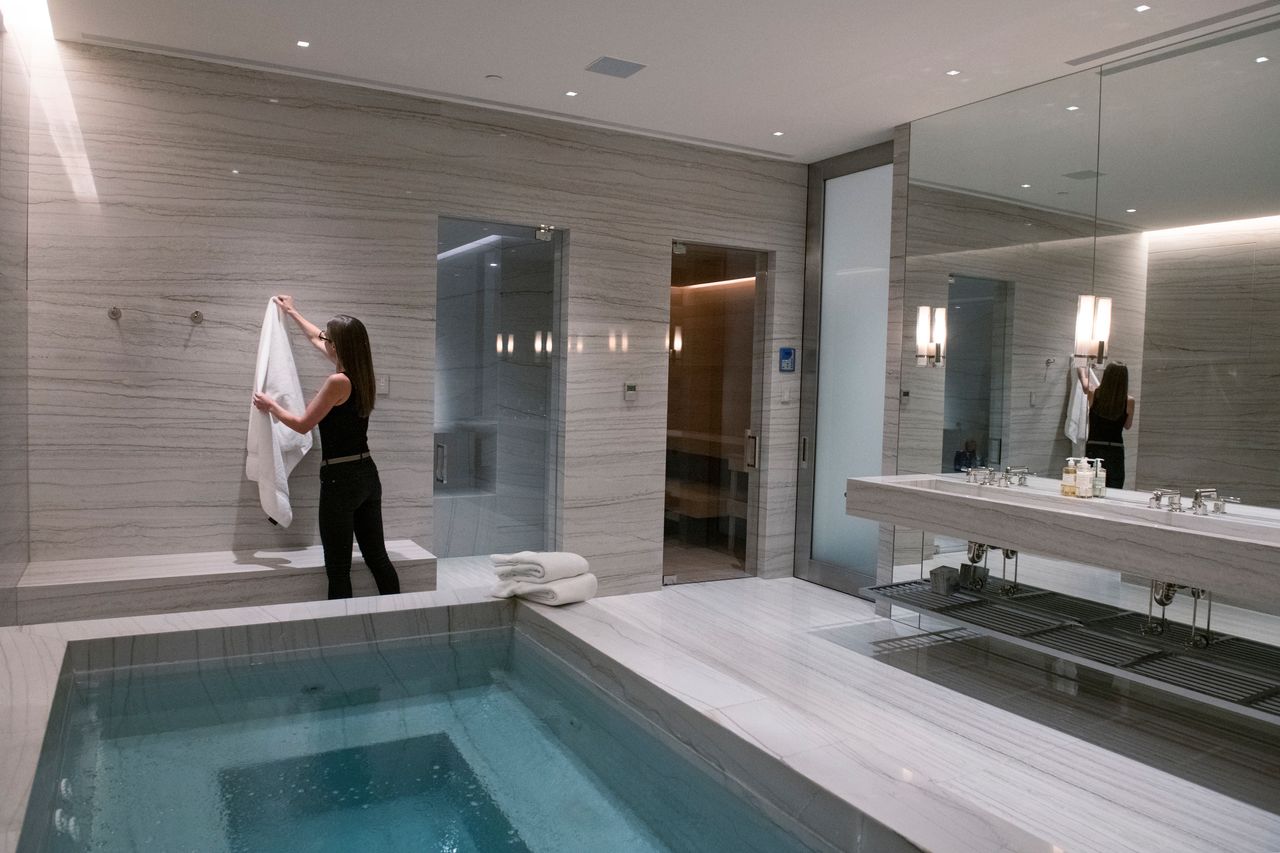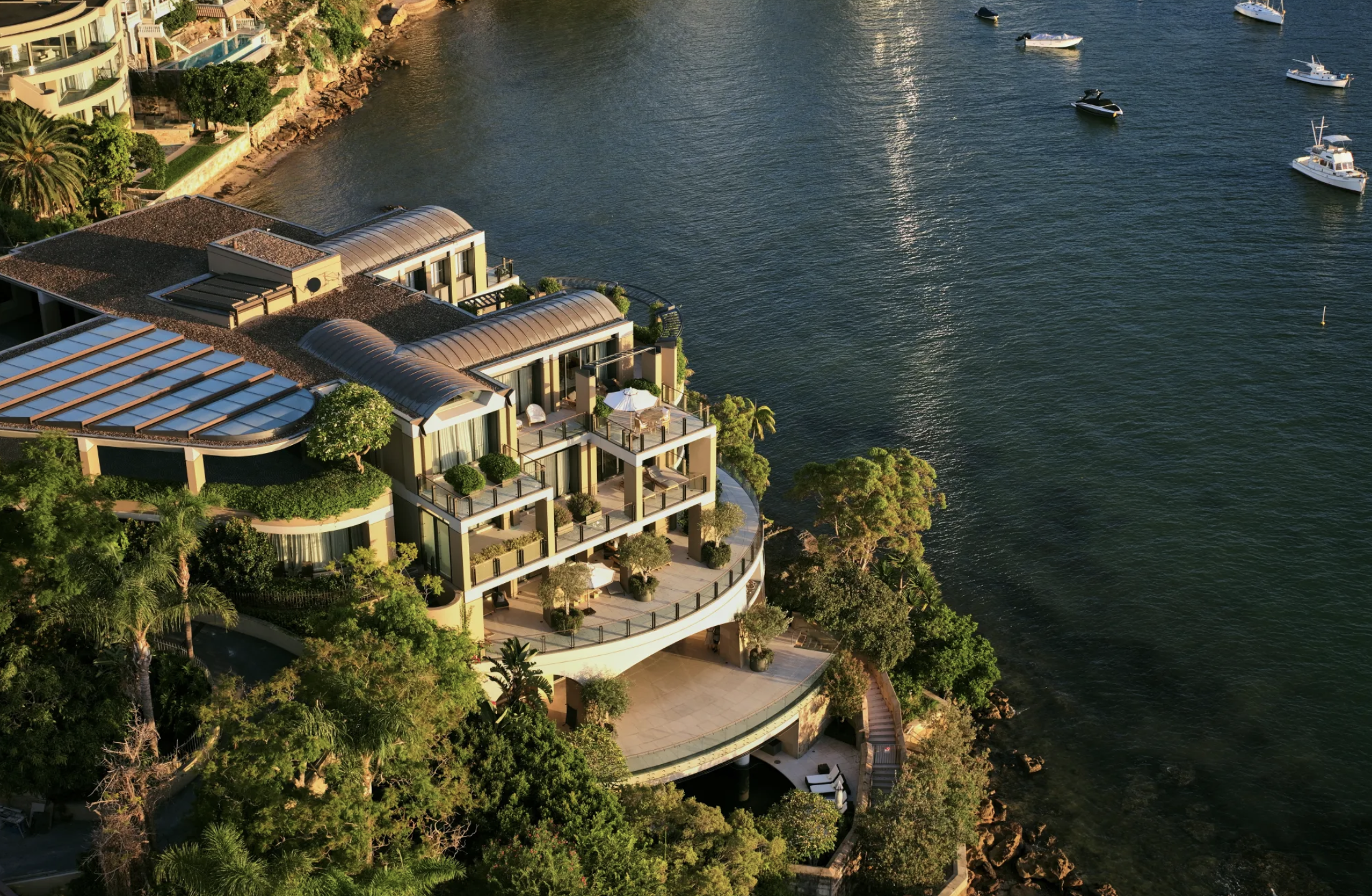There’s a New Menace Stalking Suburbia. Meet the McBasement.
Limits on above-ground mansion sizes lead to mammoth grottos with tennis courts and whiskey-tasting rooms. Beverly Hills pushes back: `Violence against the land’
When Sterling McDavid’s parents bought a roughly 9,000-square-foot home on Aspen’s Red Mountain, the 33-year-old interior designer directed the architect and contractors to start digging.
Limited by zoning above ground, Ms. McDavid, who led the renovation, envisioned an expansive basement with a world-class gym, guest suites and hotel-caliber spa for her parents, former college track star Stacie McDavid, and David McDavid, a former owner of the Dallas Mavericks and car-dealership mogul.
“I love a basement,” says Ms. McDavid, who ultimately blew out her parents’ basement to more than double its size. “When you walk into a home, if all the magic is just within the first few steps, that’s no fun.”
Wealthy Londoners have long built basements reaching two, three, and even four stories below ground. Now, there is a cellars market in the U.S. among property owners facing restrictions on mansion sizes above ground. The McBasements of today have bars, bowling alleys, pools, climbing walls and whiskey-tasting rooms. To sidestep subterranean gloom, builders usher in natural light via grand staircases or skylights cut into the ground above.
“Down is the new up,” says Randy Correll, partner at Robert A.M. Stern Architects, who designs basements with luxe finishes. “Twenty years ago, basements were the ‘B word.’”
Ms. McDavid says the excavation for her parent’s 4,000-square-foot Aspen basement added about a year to the three-year renovation, since workers dug underneath the home and into a mountainside. The resulting basement has guest suites, a gym with white oak floors, a 12-person hot tub and an “absurdly large” steam room, she says. “You feel like you’re in a luxury cave.”
She says the prior owner, by contrast, had done little to maximise the basement, which was “absolutely heinous.” (“It had wine storage, not to be confused with a wine cellar,” she says.)
Still, some towns have cracked down on the chic crypts, worried about unsettling topography and having truckloads of excavated dirt roll through residential streets. In Aspen, a resident sued the city for permitting a neighbour’s two-story basement, alleging excessive noise and dust. Aspen now limits basements to one level. And the Beverly Hills Planning Commission is now mired in a down-and-dirty basement brouhaha.
The island of Nantucket, just 14 miles long and 3.5 miles wide, limits home sizes with more than 20 zoning districts. Some areas allow a footprint covering only 2 percent of the property.
One solution? Go low. “The possibilities are endless,” says Stephen Cheney, owner of Cheney Custom Homes, who is currently constructing a roughly 16,000-square-foot home and guest home with a 5,600-square-foot “bunker” below for a bowling alley, 3-D golf simulator, and spa.
Basements can dwarf homes above. Designer Andrew Kotchen, a principal at Workshop/APD, is working on a 5,000-square-foot Nantucket abode that will have a 10,000-square-foot basement with a basketball court, garage, bedrooms and a wellness space.
In beach towns, architects are deploying extreme waterproofing measures.
For the 10,000-square-foot grotto, workers are using the same waterproofing technique as Boston’s Big Dig highway project, Mr. Kotchen says. An emergency pump system and thick concrete slab underneath will prevent the foundation from floating up should water levels rise, he says.
In Aspen, a 5,000-square-foot basement at the confluence of two rivers required “dewatering,” says Ryan Walterscheid, a partner at architecture firm Forum Phi. Workers drilled wells around the site and pumped out almost a billion gallons of water before pouring the foundation. (The water was poured back into the river.)
Architect Charles Cunniffe, who designed the McDavids’ remodel, also did a basement with a tennis court. “You can’t hit big lob shots,” he says, “but you can play a decent game of tennis.”
Interior designer Bryan Graybill says a large basement at his home in East Hampton, N.Y., was the only way to fit all the amenities he and his husband desired in their 4,100-square-foot house. For frequent hosting, their 1,800-square-foot lower level has full guest quarters, a laundry room with three sets of washers and dryers, and a catering pantry with extra stemware and service for 48. “It’s like an instant party,” he says.
Beverly Hills residents are also keeping up, and down, with the neighbours.
Architect Paul McClean crafted a house there with 7,400 square feet above ground and another 12,000 below, including a 3,000-square-foot garage. The firm also designed developer Nile Niami’s roughly 105,000-square-foot Los Angeles megamansion “The One,” where about half the home sat below grade. First listed at $500 million, the property fetched $126 million at auction this year. (A relative bargain-basement deal.)
Beverly Hills leaders passed ordinances in recent years in response to what Craig Corman, former Planning Commission chairman, called a “pernicious” trend of mammoth dwellings with wedding cake-style retaining walls and massive basements. “They can be quite offensive,” he said during a recent commission meeting. Now, property owners in the Hillside area cannot remove more than 3,000 cubic yards of earth without special permits.
This has hampered real-estate investor David Taban, who is trying to build a 23,144-square-foot house, of which 9,829 would be a basement. (He wants to dig down to appease neighbours who worried his home would hurt their views.) But getting a basement of that size required removing 5,346 cubic yards of dirt, which one city planner said would amount to 594 truckloads.
“Violence to the land,” Planning Commission Chair Myra Demeter dubbed it at an August meeting.
Asked to revise, Mr. Taban’s team is set to return to the commission Thursday. As of late September, plans called for removing just 3,276 cubic yards of soil, according to attorney Ronald Richards, a representative for Mr. Taban, who also argued the project should be permitted since the proposal predates some restrictive rules.
“It’s not even that crazy of a project in our mind,” says Russell Linch, another Taban representative.
Spec developers know the more liveable space, the bigger the price tag, says Brett Loehmann, a project manager at McClean Design. “If you don’t have great amenities, you’re not going to be the coolest person on the block.”
 Copyright 2020, Dow Jones & Company, Inc. All Rights Reserved Worldwide. LEARN MORE
Copyright 2020, Dow Jones & Company, Inc. All Rights Reserved Worldwide. LEARN MORE
Records keep falling in 2025 as harbourfront, beachfront and blue-chip estates crowd the top of the market.
A divide has opened in the tech job market between those with artificial-intelligence skills and everyone else.
Ready to level up your cellar? Here, LANGTONS Head of Auctions, Michael Anderson, selects the bottles to chase from Bordeaux 2022.
There are Bordeaux drops and then there are Bordeaux moments. This is the latter. The 2022 vintage has arrived through LANGTONS with depth across communes and enough quality to satisfy both the curious and the die-hard.
Here is your guide to what deserves a place in the cellar, and in years to come, your dining table.
1. Château Carbonnieux Blanc 2022, Graves, $110
The story of the legendary white of Château Carbonnieux Blanc (Graves, $110) stretches back to the 18th century when, thanks to its crystal clarity, it was introduced to the Sultan of Constantinople’s palace disguised as ‘mineral water from Carbonnieux. Today, the wine retains that luminous freshness in youth but develops dried and candied fruit characters with maturity, making it one of the most versatile whites in the region. This is a wine that can be drunk now through to 2029, so not a long termer.
2. Château Figeac 2022, St-Émilion, $850
If Carbonnieux speaks of crystalline youth, Château Figeac (St-Émilion, $850) speaks of longevity. Few estates can match its claim to 2000 years of continuous occupation, and the 2022 vintage bears that gravitas. Deeply garnet in colour, Cabernet Sauvignon shines here with notes of blackcurrant, blueberry, lilac, tobacco and bay leaf. On the palate, the wine is elegant and mineral, yet vibrantly alive. It’s a stunning effort that will reward those with patience – I’d suggest drinking from 2034–2060. It’s a great investment wine given Figeac’s ascent, too.
3. Château Gazin 2022, Pomerol, $235
In Pomerol, the quiet achiever is Château Gazin ($235), whose neighbours happen to be Petrus and L’Evangile. The 2022 shows deep crimson colour, with aromas of violet, musky plum, roasted chestnut and mocha. Classically proportioned, it offers a palate of ripe black fruits, chalky tannins and mid-palate depth that places it among the appellation’s most compelling releases. This wine sees its best drinking between 2029 and 2040.
4. Château Palmer 2022, Margaux, $1,050
Further south in Margaux, Château Palmer ($1,050) continues its reputation as a ‘Super Second’, officially ranked a Third Growth but revered as the equal of the First Growths. The 2022 is abundant in blackberry jam, chocolate, lavender and smoke, a wine of sheer extract and richness with remarkable intensity. It is best from 2035 and should be showing nicely to 2065. It’s a wine nipping at the heels of the Firsts and a wonderful investment opportunity.”
5. Château Haut-Bailly 2022, Pessac-Léognan, $415
Another of Bordeaux’s historic properties, Château Haut-Bailly (Pessac-Léognan, $415), dates to the mid-15th century. Its 2022 vintage shows blackcurrant pastille, violet and graphite, with a refreshing yet dense palate that finishes chalky and minerally. It is incredibly elegant now, so try from 2030–2045 with ease. A wine worth buying 6–12 bottles of to watch this ‘value’ Bordeaux evolve in the cellar over time.
6. Château Pontet-Canet 2022, Pauillac, $330
The Pauillac commune offers two contrasting but equally celebrated estates. Château Pontet-Canet ($330), founded in 1725, is full-bodied and packed with ripe black fruits supported by finely integrated tannins. The wine is remarkably compelling now, but best after 2029 through to 2045. It’s also a hit in the secondary market amongst speculators.
7. Château Lafite-Rothschild 2022, Pauillac, $1,950
Then there is Château Lafite-Rothschild (Pauillac, $1,950), perhaps the most recognised name in the Médoc. The 2022 vintage has immense grip and presence, offering loganberry, blueberry, wet stones, and forest floor. For me, this is one of the definitive wines of the vintage. It’s one of the world’s most collected and cellared wines. Best from 2034–2070+ and is a triumph.
8. Château Montrose 2022, St-Estèphe, $595
North in St-Estèphe, Château Montrose ($595) demonstrates why this Second Growth is often regarded as a rival to the First Growths. Ample blackberry, cassis and briary fruits meet velvety tannins and cedar, creating a wine of both richness and precision. The wine is fine, aromatic and worth the investment. Most joy to be extracted from 2033 onwards with a 25-year satisfaction window.
9. Château Suduiraut 2022, Sauternes, $99
The sweet wines of Bordeaux complete the spectrum. Château Suduiraut (Sauternes, $99), a neighbour to d’Yquem, delivers a 2022 that is full of marmalade, saffron, lime and orange zest. Its sweetness is cut with a lifted bitterness that lends focus. This wine is showing beautifully now and best from 2028–2035+.
10. Château Cos d’Estournel 2022, St-Estèphe, $690
Finally, another St-Estèphe giant, Château Cos d’Estournel ($690), speaks with intensity and power. A blend dominated by Cabernet Sauvignon and Merlot, the 2022 is tannic, commanding and built for the long haul like every vintage of Cos.
Now complete, Ophora at Tallawong offers luxury finishes, 10-year defect insurance and standout value from $475,000.
A divide has opened in the tech job market between those with artificial-intelligence skills and everyone else.
























